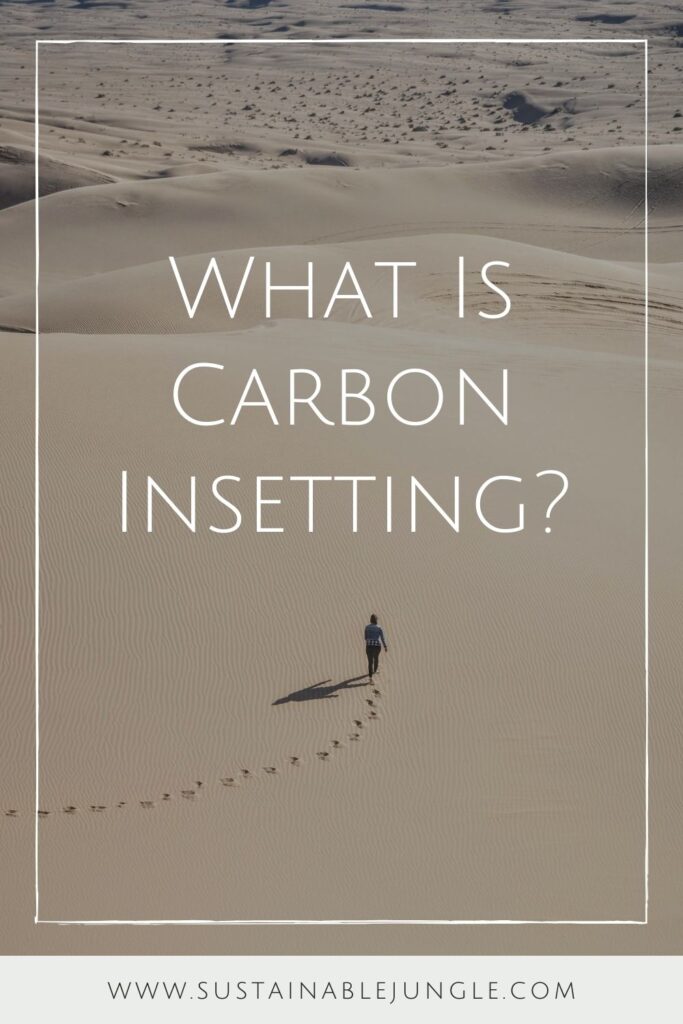
Insetting: What Is It and How Does It Differ from Carbon Offsetting?
If you’ve take steps to reduce your carbon footprint, then you’ve (almost) certainly heard of carbon offsetting.
But what is carbon insetting?
Insetting is an emerging mechanism for companies to reduce carbon emissions and store carbon by investing in interventions within their own value chain.
Okay, so that sounds very corporate(y)…and it is. It’s primarily designed for companies and businesses to help them tackle the monster-sized problem of climate change and biodiversity loss.
But what in this carbon-filled world does that actually mean, you say?!
While carbon offsetting typically involves payments to carbon offset projects (via third party offset providers) that capture or sequester carbon dioxide elsewhere; carbon insetting focuses on avoiding, reducing, and sequestering emissions in upstream or downstream operations.
This can mean finding more sustainable sources for raw materials, planting native trees in the local community, or investing in biodegradable packaging, but there are more ins and outs to insetting than these simple examples.
Still confused over this carbon conundrum?
Offset the upset of climate change by learning more about insetting below.
QUICKLINKS FOR CARBON INSETTING
- What is Carbon Insetting?
- What are Some Examples of Carbon Insetting?
- What is Carbon Offsetting?
- Offsetting vs Insetting
What is Carbon Insetting?

The International Platform for Insetting’s (IPI) definition of insetting is as follows:
“Insetting is a way for companies to harmonise their operations with the ecosystems they depend upon and transition to a more sustainable business model”.
In this context, “Ecosystems” can be interpreted to be a corporate or business value chain.
A value chain can involve upstream activities such as raw materials production while downstream activities could include actually selling the product.
Using a fashion industry example, upstream activities in the value chain could be the farming of organic cotton while downstream activities would include retailing the final product in a store.
Insetting interventions address Scope 3 emissions within a value chain, which are the indirect emissions generated from production of the goods a company purchases or from the sale of their products – in other words, these are the emissions that they themselves don’t directly generate but are caused by their business activities.
But don’t be fooled; although carbon insets address “indirect emissions”, there is actually a more direct impact from the perspective of climate action!
This is because companies are forced to look at their own business operations and invest in sustainable management practices directly at the source. This is opposed to carbon offsets, which almost always benefit projects elsewhere.
By engaging in carbon insetting, companies are investing in making their own products and practices more sustainable.
Many carbon insetting projects are focused on regenerative agriculture or agroforestry because the bulk of carbon emissions generated during the making of a product often comes from the land use footprint (growing, planting, and cultivation).
For instance, most large food suppliers buy their food from farmers, then process and distribute. When they purchase carbon offsets, they only have to offset the emissions from processing and distributing.
But what about the negative environmental impact of the land use, soil degradation, and deforestation from the food itself?
That’s where insetting comes in.
When companies focus on making their initial input better by investing in projects that help increase biodiversity, prevent monoculture crops and deforestation, or promote soil health, they are creating positive change that will be felt throughout their “sphere of influence”.
What are Some Examples of Carbon Insetting?

The IPI appears to be the current authority on insetting. It is a not for profit membership organization that was founded in 2015 by three corporate members including Accor, Nespresso and Chanel. L’Oréal and Kering have since joined as members.
The IPI has published the Insetting Program Standard, the idea being that this standard will help companies develop a holistic insetting program.
They have several case studies highlighting examples of insetting from their member group.
We provide a summary of Kering’s carbon insetting example below:
Kering, a luxury goods corporation that owns iconic fashion brands including Gucci and Balenciaga, participated in an insetting project in Mongolia, where they source their cashmere.
They partnered with the Wildlife Conservation Society to create a solution for the overpopulation of goats due to growing cashmere demand. The surging goat population degraded native grasslands and led to herd starvation.
By implementing sustainable pasture management practices such as rotational grazing, as well as more advanced herd management practices and animal welfare training, they:
- Reduced the negative impacts of cashmere production upstream
- Improved fiber quality
- Improved biodiversity conservation
- Improved the health and condition of the goats
- Helped herders by helping build models to monitor and predict pasture quality
By investing in this inset project to work towards more ethical cashmere production, they improved their product, supply chain, and relationship with suppliers. And they helped the environment and ecosystem as well.
Insetting is intended to be a win-win all around!
What is Carbon Offsetting?

So how does carbon offsetting work, and what are some examples of carbon offsets?
Carbon offsets often take the form of monetary support for programs or projects that either sequester carbon dioxide from our environment or prevent additional emissions.
Organizations like Carbon Fund and Cool Effect host a multitude of different projects and programs you can browse on their websites, including preserving black bear habitat in Alaska, protecting trees in the Amazon, and supporting renewable energy initiatives around the globe.
Building on our fashion industry example, a brand that is carbon offsetting would pay one of these carbon offsetting organizations to invest in carbon reducing projects in their quest to become carbon neutral.
Offsetting vs Insetting

What is the difference between offsetting and insetting, and what are some pros and cons?
First, it’s important to note that insetting carbon is not an alternative to offsetting carbon. They can (and should!) be used together to effectively reach sustainability goals.
Here are some of the main differences between insetting and offsetting:
Scope:
One criticism of insetting is that they are limited in scope. Only those companies with a suitable value chain can really engage in them, and there is no way to become carbon-neutral solely by using carbon insets.
Offset projects are open to anyone and any company can become carbon-neutral or carbon-negative using offsets.
Location impact:
One big difference is that carbon offsetting projects are often done elsewhere. They almost never address the local impact of a company’s or individual’s emissions.
Success rates:
Some carbon offset programs don’t follow through on their promises or wind up unsuccessful. It’s why it’s always important to know which offset programs are reputable before giving them money.
In contrast, one of the benefits of insetting is that businesses invest in the ecosystems and raw materials that their suppliers depend on, creating change in their own value chain.
Measurement, certification and verification:
It can be harder to quantify and measure the impact of internal insetting projects, especially if a company is trying to make a carbon claim. Instead, companies pioneering insetting appear to be more focused on the holistic impact of these projects.
Carbon offset projects, on the other hand, can access reputable certification bodies that quantify the offsets.
Potential for greenwashing:
Another criticism of offsets is that paying for them offers little incentive for companies to reduce emissions in their own backyard and truly change the way they do business.
It can encourage greenwashing by offering a bought solution or easy fix where companies can effectively pay for a sense of “peace of mind”.
Carbon insets are designed to encourage engagement within a company’s ecosystem and help them reach their sustainability goals while also supporting and improving the supply chain they know best.
While engaging in inset projects undoubtedly has a noble intent, there is of course also room for greenwashing.
Final Thoughts on Carbon Insetting
Carbon insets are investments in a more sustainable future.
To help make the concept of insetting relatable, think about your own waste streams and how you can implement insetting in your own life (perhaps choosing a socially responsible investment firm or one of the B Corp banks, and employing a few zero waste tips).
And if you’re still feeling overwhelmed, try gleaning some inspiration from our recommended list of sustainability books or by watching a zero waste documentary.
If you have a friend who also cares about their carbon footprint, share this article with them – after all, companies and businesses aren’t the only ones that might need some insetting insight.
Whether you’re an individual trying to lead a sustainable lifestyle, or a company set on achieving carbon neutrality and zero waste, consider your inputs and outputs and how you can have a positive impact on your own “sphere of influence.”
Carbon insetting may not be the end-all solution to a carbon-neutral world, but it’s a good place to start.




